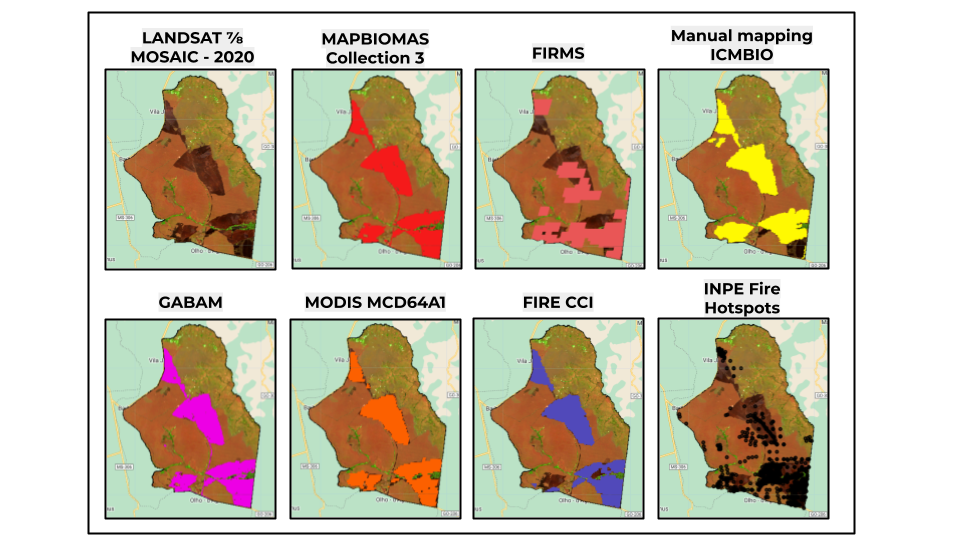Here we present a summary of the method developed and applied in Collection 4 for mapping fire scars in Brazil (1985-2024). For more methodological details, access the ATBD (Algorithm Theoretical Basis Document) at this LINK.
GENERAL CHARACTERISTICS
All mapping of fire scars in Brazil was based on mosaics of Landsat satellite images with a spatial resolution of 30 meters. The mapping period covers from 1985 to 2024, with monthly and annual burn scar data covering the entire Brazilian territory.
The process was carried out collaboratively among MapBiomas institutions, using artificial intelligence with machine learning algorithms (deep learning) on Google Earth Engine and Google Cloud Platforms, which offer a huge cloud processing capacity, beyond local servers for additional processing.
The work was organized by biomes and regions, with sample collection in burned and unburned areas for training the algorithm by region. In addition, reference maps were used, such as the MODIS Burned Area product (MCD64A1 – https://lpdaac.usgs.gov/products/mcd64a1v006/) with a spatial resolution of 500 m, GABAM (Global Annual Burned Area Map - https://gee-community-catalog.org/projects/gabam/) with 30 m resolution, fire hotspots, and burn scars from INPE (https://terrabrasilis.dpi.inpe.br/queimadas/bdqueimadas/).
2. METHOD OVERVIEW
The image processing and classification routines used to map burned areas in Brazil followed six stages:
- Definition of classification regions by biome: The biomes were divided into regions to increase the accuracy of the classification.
- Creation of annual Landsat mosaics: An annual statistical approach was used to create quality annual mosaics by composing all 16-day images into a single mosaic, selecting the pixel with the lowest NBR (Normalized Burn Ratio) value.
- Collection of training samples: Spectral signatures of burned and unburned areas were collected from the annual mosaics to make up the model's training sample set.
- Classification with a Deep Learning model: The DNN (Deep Neural Network) model was trained using the collected samples and the RED, NIR, SWIR1 and SWIR2 spectral bands to classify burnt areas.
- Post-classification: Masks and spatial filters were applied to improve accuracy and reduce noise in the classification results.
- Validation with reference data and visual checks: The classification results were validated using reference data, along with visual checks.
2.1. DEFINITION OF REGIONS BY BIOME
For each biome, regions were defined for the collection of training samples and the classification of burned areas by region, with the aim of obtaining a more accurate classification based on edaphoclimatic factors and regional vegetation. The following regions were defined for each biome:
2.2. ANNUAL MOSAICS
The classification was performed using surface reflectance (SR) mosaics from the USGS Landsat Collection 2 (Tier 1) (30m × 30m), constructed for each year from 1985 to 2024. All available scenes from the Landsat 5 (1985 to 2011), Landsat 7 (1999 to 2021), Landsat 8 (2013 to 2024), and Landsat 9 (2022 to 2024) satellites were evaluated, with a 16-day return interval.
2.3. SAMPLE COLLECTION
We created a spectral library based on the manual delineation of burned and unburned areas to be used as training samples. These samples were stratified by Landsat sensors (collected in different years) and by each biome. The collection of training samples was carried out across all 28 classification regions, ensuring the representation of the distinct spectral characteristics present in each region.
Thus, we obtained a sample set per sensor and for the 28 regions of Brazil, to be used for training the classification model.
2.4. CLASSIFICATION
The classification model used was the Deep Neural Network (DNN), which consists of computational models based on mathematical calculations capable of performing machine learning and visual pattern recognition.
The burned area mapping algorithm consisted of two phases: training and prediction. Based on the training samples of burned and unburned areas, the following spectral bands were used as input for the burned area classification model: red (RED – 0.65 µm), near-infrared (NIR – 0.86 µm), and short-wave infrared (SWIR 1 – 1.6 µm and SWIR 2 – 2.2 µm). These Landsat spectral bands were chosen due to their sensitivity to fire events.
The training data were divided into two sets: 70% of the samples were used for training and 30% for testing.
2.5. POST-CLASSIFICATION
After training and testing the model, the classification was applied using bi-weekly Landsat imagery for the entire analysis period (1985 to 2024). A spatial filter was applied to remove noise and fill small empty gaps: areas smaller than or equal to 1.4 hectares (16 pixels) were removed, and empty gaps smaller than or equal to 5.8 hectares (64 pixels) were filled as burned areas.
Após a avaliação dos resultados da classificação, foram aplicados filtros de pós-classificação para remover pixels que estavam nas seguintes classes de cobertura e uso da terra da Coleção 9 do MapBiomas nos biomas:
- Amazon: Water, Urban Area, Mining, Beach, Dune and Sand Spot
- Caatinga: Water, Urban Areas, Rocky Outcrop
- Cerrado: Water, Urban Areas and Mining
- Atlantic Forest: Water, Urban Area, Rice, Mining, Beach, Dune and Sand Spot
- Addittional for regions 6 and 7: Soy, Temporary Crop; Sugar Cane and and others Temporary Crops.
- Pampa: Water, Urban Areas, Rice, Mining, Beach, Dune and Sand Spot, Soy, Other Temporary Crops, Mosaic of Uses;
- Pantanal: Soy, Cotton and Other Temporary Crops.
To obtain the information of the month in which the fire scar was mapped, postclassification processing was performed to retrieve the information of the date of the pixel that was burned from the date of the pixel in which the annual mosaic was constructed from the minimum NBR.
2.6. RATING ASSESSMENT
Evaluations of the fire scar classification were carried out using Landsat images, through visual inspection, statistical analysis, and correlation with MapBiomas land cover and land use data. Additionally, they were compared with reference maps, including FIRMS (1 km), GABAM (30m), MODIS MCD64A1 (500m), FIRE CCI (250m), and INPE heat spots (1 km).


